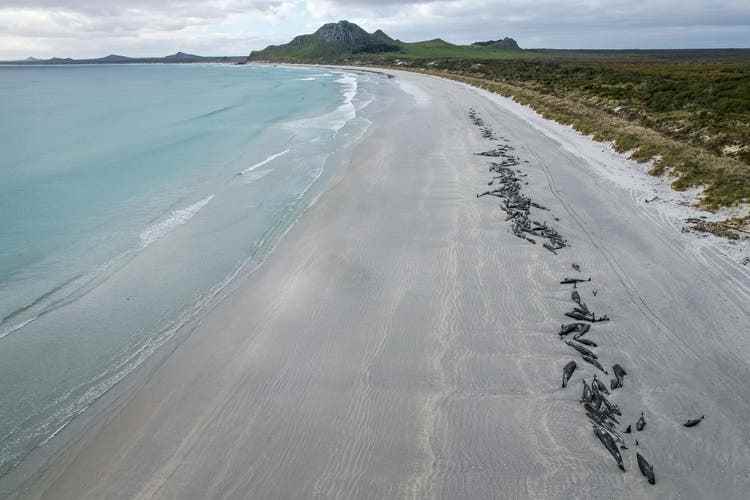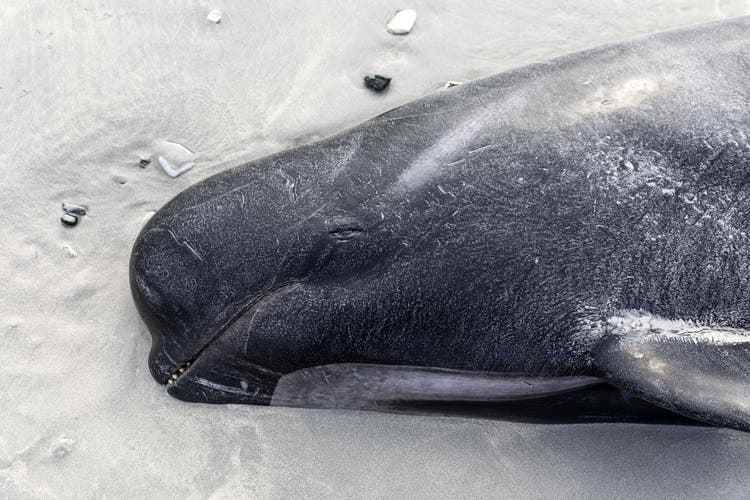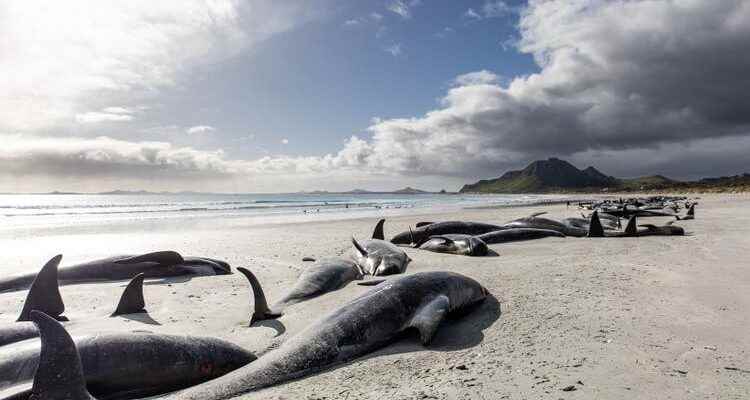Did they follow their prey into shallow water? Researchers suspect that some whales cannot cope with the topography of certain beaches.
Beached: dead pilot whales on Tupuangi Beach in the Chatham Islands in New Zealand, October 8, 2022.
When residents of Pitt Island in the Pacific discovered nearly 240 stranded pilot whales on Monday, they had no choice but to abandon them to their fate. Only forty people live on the remote island, too few to support so many whales. In addition, it would be too dangerous to drag the 800-kilogram animals into deeper waters. Because Pitt and the neighboring islands that form the Chatham Archipelago are surrounded by great white sharks.
“We don’t actively herd whales in the Chatham Islands because of the risk of shark attacks on humans and the whales themselves,” said Dave Lundquist, marine affairs adviser to the Department of Conservation. When his colleagues arrived on site, some of the whales were already dead. The remaining whales were euthanized to minimize suffering and left on the beach to decompose.
It was the second mass stranding that conservationists had to respond to in a matter of days. About 240 pilot whales also died on Chatham Island, 20 kilometers to the north-west, on Friday. As shocking as the images may be, they are not unusual. They’ve been around for thousands of years.
The New Zealand Conservation Agency responds to an average of 85 strandings per year, usually solitary animals. However, there are several “hotspots” where dozens or even hundreds of animals are stranding: in Golden Bay and Stewart Island off New Zealand’s South Island, and on the Chatham Islands, some 840 kilometers to the east. The largest known stranding concerned an estimated thousand pilot whales on the Chatham Islands in 1918.
Reasons for mass strandings mostly remain a mystery
Massey University’s Emma Betty is one of the researchers studying stranded whales in New Zealand and Australia. She directs the post mortem facility at the University of Auckland. While the reasons for strandings remain a mystery in most cases, researchers believe that individual whales or dolphins strand because they are sick or injured and are nearing the end of their natural lifespan. Ship accidents, underwater noise and plastic pollution are known threats to the mammals.
The reasons for mass strandings are controversial, there are numerous theories. Betty explains that mass strandings tend to occur on long, gently sloping beaches that are considered natural “whale traps.” She suspects that species unfamiliar with this type of topography and the associated tides and currents miss the moment to retreat to the deep sea when they swim through water that is becoming increasingly shallow.

240 animals perished in the October 8, 2022 mass stranding at Tupuangi Beach on the Chatham Islands in New Zealand.
Once stranded, whales are crushed by their own body weight. That explanation fits with data showing that open-ocean species like pilot whales are the most stranded, Betty said. Cetaceans that live close to the coast, such as dolphins, are well acquainted with the coasts and the associated dangers and rarely strand.
Summer: season of strandings
In New Zealand, most pilot whales strand in the summer, between October and February. “Nobody knows exactly what attracts the pilot whales to the coastal waters in the summer months,” says Betty. However, there are indications that during these months they were their prey – Squids, cuttlefish and fishing – follow into shallower waters. “Maybe the prey preferences of the animals change with the seasons or with their breeding cycle,” says Betty.
However, this cannot be confirmed with certainty. Because pilot whales largely elude human surveillance: they cannot be located with satellites and they cannot be tracked by boat either, says Betty, after all their habitat is many kilometers away from the coast – in areas outside the continental shelf, where they dive down to a thousand meters and use echolocation to hunt for large squid.
However, it is possible that human facilities confuse or cause stress to the whales. In order to protect the animals from stranding, the New Zealand nature conservation authority repeatedly prevents the installation of sonar reflectors or noise-generating devices near the coast.
Did they want to help other whales?
Another theory as to why pilot whales are stranded en masse could be due to their very sociable behavior. Pilot whales live up to 60 years and usually live together in close-knit groups of 20 to 100 animals called pods. “It’s likely that the social cohesion of whales leads them to come ashore when other members of their group are in distress,” says Betty.

Living in large groups: stranded pilot whales on Tupuangi Beach on the Chatham Islands in New Zealand, October 8, 2022.
Therefore, when rescuers and volunteers drag stranded whales into the sea until they can swim themselves, they make sure that the animals leave the beach together or in large enough groups not to encourage the urge to return. No help was available for the whales stranded on the Chatham Islands. Their carcasses will now attract a range of scavengers, including birds and sharks, who will rejoice in an easy meal.
